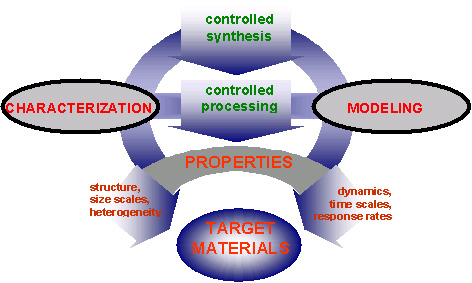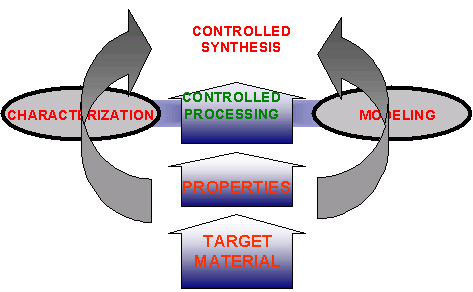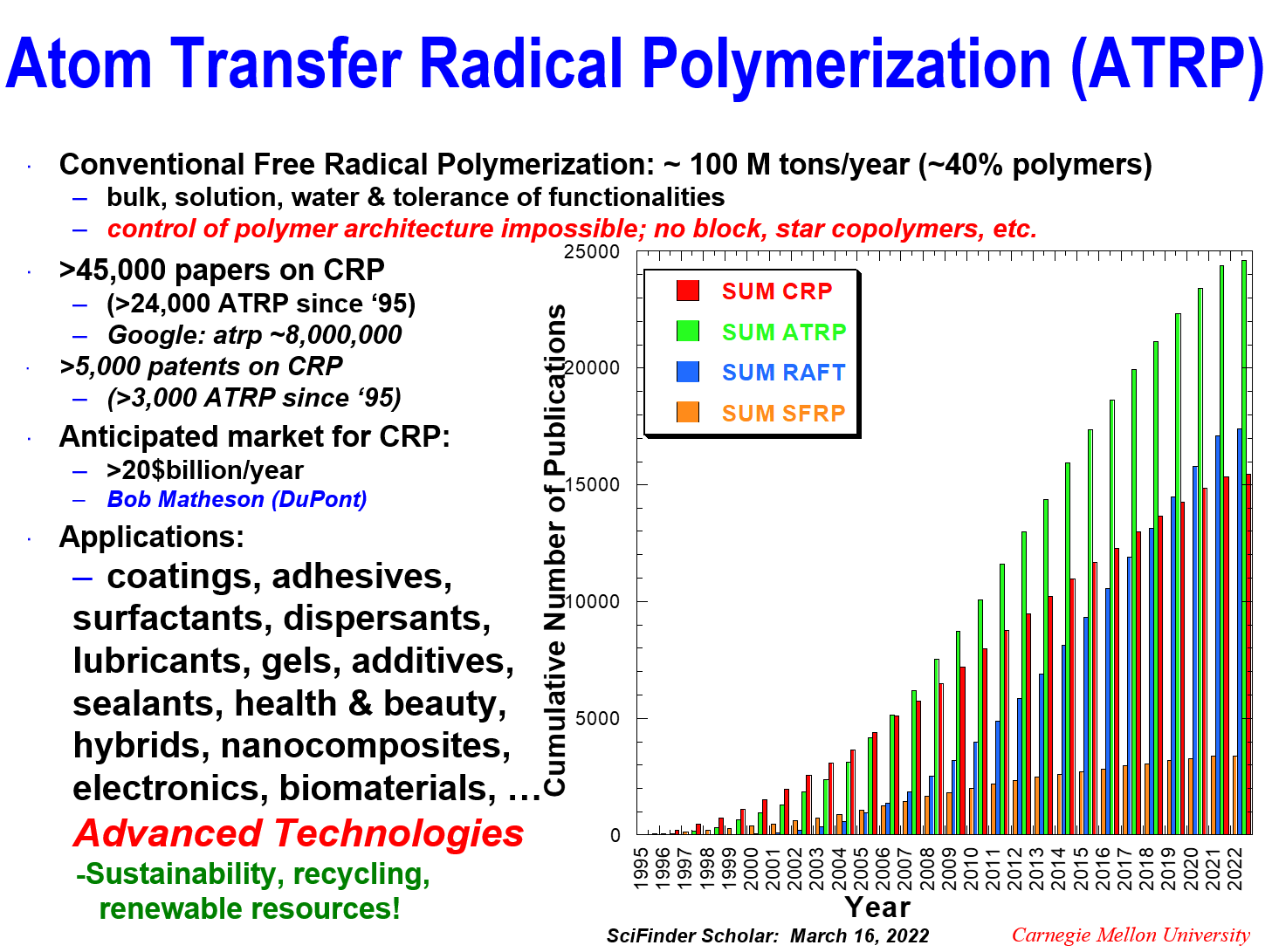Objectives
- The main objective of the CRP Consortium is to assist the Member corporations develop materials for their markets based on controlled radical polymerization.
- The Center for Macromolecular Engineering will interact with Consortium Members as requested for staff training and to address any questions on material development.
- The University will continue to protect the technology developed within the Consortium to provide a strong Intellectual Property position for licensees.
Technology Focus
The present technical focus of the CRP Consortium is to increase the efficiency of a research organizations effectiveness by development of a comprehensive structure - property correlation where the properties of a target material can be met through controlled synthesis of functional monomers followed by controlled processing. The process will be amplified by detailed physical analysis and by modeling the processes providing an understanding of material properties based on the composition and structure of the polymer, size of phase separated domains and the dynamics of testing response rates.

Ultimately this figure will be turned on its head with the desired properties for any target application driving the synthesis and fabrication steps.

History and Present Status of CRP
The understanding and application of controlled/living radical polymerization (CRP) has undergone tremendous growth in the past decade and continues to break new ground in the preparation of advanced polymeric materials.
As shown below, over ~45,000 papers have been published on CRP (~24,000 on ATRP since 1995). This is not just academic interest since ~5,000 patents on CRP have issued (~3,000 issued US patents on ATRP and ~1,350 published US applications incorporating the abbreviation "ATRP" since Oct. 2001).

The driving force for this significant research effort is an anticipated market of > $20 billion/year for products made by CRP.(Bob Matheson (DuPont) at Knowledge Foundation Conference on Commercialization of Controlled Polymer Synthesis, December 4-5, 2000)
The development of new polymers with predetermined well defined structure will allow manufacturers to improve the properties of materials currently in the marketplace.
The synthesis of completely new materials will allow many companies to retain or expand current markets and develop new markets in addition to providing innovative solutions to problems faced by consumers of current commercial products.
Target applications include coatings, adhesives, surfactants, dispersants, lubricants, gels, additives, thermoplastic elastomers, bulk performance materials, membranes, personal care products, detergents, materials for electronics, biomaterials, drug carriers, etc...
Carnegie Mellon has been at the fore of CRP beginning with our early work on nitroxide mediated stable free radical systems, followed by degenerative transfer using alkyl iodides and extended with our current work with the highly successful atom transfer radical polymerization (ATRP).
ATRP research was primarily supported by the ATRP industrial research consortium whose term expired at the end of year 2000.
The ATRP Consortium was highly successful and focused on the development of ATRP as a viable method for the commercial synthesis of well-defined polymers.
During the first ten years of the CRP Consortium we have continued to focus on ATRP. We successfully developed more efficient catalyst systems, systems where the catalyst can be employed on a solid support or recycled, or with ppm levels of a continuously regenerated catalyst and new aqueous based methodologies for the preparation of well-defined functional polymers.
The CRP Consortium will continue to expand its work on all approaches to controlled radical polymerization including the examination and development of other CRP technologies, i.e., nitroxide based and degenerative transfer processes, including RAFT. Indeed we have developed a simple and convenient approach to RAFT transfer agents, Macromolecules 2009, 42, 3738-3742.
To remain at the leading edge of CRP technology, we also aim to explore the development of new CRP systems.
As noted above we plan to correlate and better understand the effects of macromolecular structure on physical properties; this work is ongoing and is to be done in collaboration with numerous research groups around the world, taking advantage of their individual areas of expertise in materials characterization and computer simulations.
Comparative Advantages of Different CRP Processes
We realize that each technology has its limitations, in addition to many benefits, and the following schematic shows one interpretation of the relative advantages and limitations of ATRP, NMP and RAFT as applied to the synthesis of low (LMW) and high molecular weight polymers (HMW), range of polymerizable monomers (Mon Range), preparation of block copolymers (Blocks), end-functional polymers (End Funct), Hybrids , aqueous systems (Water) and some environmental issues (Env)..

Our goal is to define the scope of each technology to empower the polymer chemist with a library of techniques to develop polymers with the desired properties for any given application at the lowest cost.
The schematic illustrates how the scope of each of the three major CRP procedures have expanded in the past decade with RAFT retaining an advantage in range of monomers and ability to prepare HMW polymers while ATRP retains its advantage in LMW copolymers, Hybrids, end functionalization and preparation of block copolymers.
We are actively working to expand the utility of all CRP processes. Current ATRP research on the direct copolymerization of acidic and ionic monomers in aqueous systems will expand both the utility of water as a reaction medium and monomer range for ATRP in the above figure.
We strongly believe that there are many potential areas for property improvement over the current commercial materials that will allow introduction of new products to the market through the use of controlled radical processes.
The CME is willing work with Members of the Consortium to recommend a particular approach depending on various requirements.
CMU provides a unique opportunity to explore the application of a variety of CRP systems, not just a single technique, to aid the industrial scientist in developing new materials for commercial production.
Past and present Members of the CRP Consortium include: 3M, Aculon, Akzo Nobel, Arkema, Asahi-Kasei, Asahi Medical, Atofina, ATRP Solutions, Bayer, BF Goodrich, Biohybrid Solutions, Boston Scientific Corporation, BYK Chemie, Cabot Corporation, Centro de Investigación en Polimeros, Ciba Specialty Chemicals, Ciba Vision, Ciba Vision Novartis, CIP, Dainippon Ink, Degussa (RohMax Additives), DIC, Dionex, DSM, Elf, Encapson, Evonik (Degussa RohMax Additives), Entegris, Foshan Sheen Sun, GE, Geon, GIRSA Corporativo SA de CV, Headwaters Technology, Henkel, HTIG, JSR, Kaneka Corporation, Kilimanjaro Energy, Kuraray, LG Chem, Lion Corp., Merck, Mitsubishi Chemical, Mitsui Chemicals, Inc., Motorola, Nalco Chemical Company, Nanoderm, Nippon Gohsei, Nitto Denko, PPG, Rohm & Haas, Rohmax, Rohner AG, Solvay, Sasol Technology, Seeo, Silberline, Sinopec, Solvay, Syngenta, Teijin Limited, ThermoFisher, Warwick Effect Polymers, Zeon Chemicals.